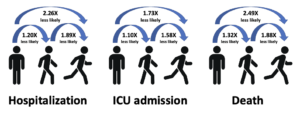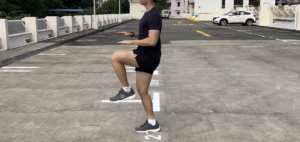Does Physical Activity Level Predict COVID19 Outcomes?
Reference
Sallis, R., Young, D., Tartof, S., Sallis, J., Sall, J., & Li, Q. et al. (2021). Physical inactivity is associated with a higher risk for severe COVID-19 outcomes: a study in 48 440 adult patients. British Journal Of Sports Medicine, 55(19), 1099-1105. https://doi.org/10.1136/bjsports-2021-104080
Objective
The US Physical Activity Guidelines recommends at least 150 minutes of moderate to vigorous physical activity (PA) per week. PA is known to bolster immunity against several diseases, and prior research have demonstrated the protective effect of PA against various forms of viral infections. However, it is not known if PA confers similar benefits against the COVID19 virus as well.
Thus, this study investigated whether meeting physical activity guidelines translates to less severe outcomes, specifically for the COVID19 virus.
What they did
The researchers employed a retrospective observational design and recruited 48440 adults with COVID19. The mean age is 47.5 ± 17 years old while the average BMI is 31.2 ± 7.07. Among the participants, 51.4% no comorbidities, 17.4% had 1 comorbidity, 31.3% had 2 or more comorbidity. In terms of PA level, 6.4% were consistently meeting PA guidelines (>= 150 mins/week), 79.2% were somewhat active (10-150mins/week), and 14.4% were consistently inactive (0-10 mins/week).
What they found

Percentage of Hospitalization:
- 10.5% of those who are consistently inactive were hospitalized
- 8.9% of those who are somewhat active were hospitalized
- 3.2% of those who are consistently meeting guidelines were hospitalized
Percentage of ICU Admission:
- 2.8% of those who are consistently inactive were admitted to ICU
- 2.5% of those who are somewhat active were admitted to ICU
- 1% of those who are consistently meeting guidelines admitted to ICU
Percentage of Death:
- 2.4% of those who are consistently inactive had deceased
- 1.5% of those who are somewhat active had deceased
- 0.4% of those who are consistently meeting guidelines had deceased

Odds of Hospitalization:
- Consistently inactive group has 2.26 times greater odds than the group that consistently meets guidelines
- Consistently inactive group has 1.20 times greater odds than somewhat active group
- Somewhat active has 1.89 times greater odds than the group that consistently meets guidelines
- Consistently inactive has 1.73 times greater odds than the group that consistently meets guidelines
- Consistently inactive has 1.10 times greater odds than somewhat active (although not statistically significant)
- Somewhat active has 1.58 times greater odds than the group that consistently meets guidelines
- Consistently inactive has 2.49 times greater odds than consistently meeting guidelines
- Consistently inactive has 1.32 times greater odds than somewhat active
- Somewhat active has 1.88 times greater odds than consistently meeting guidelines
Limitations:
- The direction of association could be reversed; that is, those who have comorbidities may not have the capacity to engage in PA. As such, the cause of poor COVID19 outcomes may have been due to presence of comorbidities rather than level of PA.
- Level of PA was self-reported, and is thus prone to biases.
- This is an observational study, hence a causational relationship cannot be established.
Conclusion
The higher the level of physical activity prior to COVID-19 diagnosis, the lower the odds of hospitalization, ICU admission and death.
Practical takeaways
This study is a useful piece of evidence that personal trainers and physiotherapists can use to further convince our clients/patients that exercise has a powerful, protective effect against transmissible diseases.
It is worth taking note that when conveying the results of this study to clients/patients, using fear appeal (i.e. choosing to report the negative effects of not exercise) may not be constructive, as shown by behavioural change research. A reward-based approach (i.e. choosing to report the benefits of exercise) tends to be more effective, and leads to longer-lasting changes in exercise routine.

